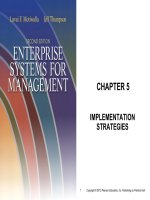Operations management, 9e by krajewski itzman malhotra chapter 05
Bạn đang xem bản rút gọn của tài liệu. Xem và tải ngay bản đầy đủ của tài liệu tại đây (528.39 KB, 96 trang )
5
Quality And Performance
PowerPoint Slides
by Jeff Heyl
For Operations Management, 9e by
Krajewski/Ritzman/Malhotra
© 2010 Pearson Education
5–1
Costs of Quality
A failure to satisfy a customer is considered a
defect
Prevention costs
Appraisal costs
Internal failure costs
External failure costs
Ethics and quality
5–2
Total Quality Management
Customer
satisfaction
Figure 5.1 – TQM Wheel
5–3
Total Quality Management
Customer satisfaction
Conformance
to specifications
Value
Fitness
for use
Support
Psychological
impressions
Employee involvement
Cultural
change
Teams
5–4
Total Quality Management
Continuous improvement
Kaizen
A
philosophy
Not
unique to quality
Problem
solving process
5–5
The Deming Wheel
Plan
Act
Do
Study
Figure 5.2 – Plan-Do-Study-Act Cycle
5–6
Six Sigma
Process average OK;
too much variation
Process variability OK;
process off target
X X
X X
XX XX
X
X
X
X
X
X
X X
X
X
Reduce
spread
Process
on target with
low variability
Center
process
X
XX
X
X
X XX
Figure 5.3 – Six-Sigma Approach Focuses on Reducing Spread and Centering the Process
5–7
Six Sigma Improvement Model
Define
Measure
Analyze
Improve
Control
Figure 5.4 – Six Sigma Improvement Model
5–8
Acceptance Sampling
Application of statistical techniques
Acceptable quality level (AQL)
Linked through supply chains
5–9
Acceptance Sampling
Firm A uses TQM or Six
Sigma to achieve internal
process performance
Buyer
Manufactures
furnaces
fan
Motor inspection
Yes
Accept
motors?
mo
tors
Firm A
Manufacturers
furnace fan motors
TARGET: Buyer’s specs
Supplier uses TQM or Six
Sigma to achieve internal
process performance
fan
bla
des
No
Blade inspection
Yes
Accept
blades?
Supplier
Manufactures
fan blades
TARGET: Firm A’s specs
No
Figure 5.5 – Interface of Acceptance Sampling and Process
Performance Approaches in a Supply Chain
5 – 10
Statistical Process Control
Used to detect process change
Variation of outputs
Performance measurement – variables
Performance measurement – attributes
Sampling
Sampling distributions
5 – 11
Sampling Distributions
1. The sample mean is the sum of the observations
divided by the total number of observations
n
x=
∑x
i =1
i
n
where
xi
n
x
= observation of a quality characteristic (such as tim
= total number of observations
= mean
5 – 12
Sampling Distributions
2. The range is the difference between the largest
observation in a sample and the smallest. The
standard deviation is the square root of the
variance of a distribution. An estimate of the
process standard deviation based on a sample is
given by
σ=
∑( x − x)
i
n −1
2
or σ =
2
x
∑ i−
(∑ x )
n −1
2
i
n
where
σ
= standard deviation of a sample
5 – 13
Sample and Process Distributions
Mean
Distribution of
sample means
Process
distribution
25
Time
Figure 5.6 – Relationship Between the Distribution of Sample
Means and the Process Distribution
5 – 14
Causes of Variation
Common causes
Random,
unavoidable sources of variation
Location
Spread
Shape
Assignable causes
Can
be identified and eliminated
Change
Used
in the mean, spread, or shape
after a process is in statistical control
5 – 15
Assignable Causes
Average
(a) Location
Time
Figure 5.7 – Effects of Assignable Causes on the Process
Distribution for the Lab Analysis Process
5 – 16
Assignable Causes
Average
(b) Spread
Time
Figure 5.7 – Effects of Assignable Causes on the Process
Distribution for the Lab Analysis Process
5 – 17
Assignable Causes
Average
(c) Shape
Time
Figure 5.7 – Effects of Assignable Causes on the Process
Distribution for the Lab Analysis Process
5 – 18
Control Charts
Time-ordered diagram of process performance
Mean
Upper control limit
Lower control limit
Steps for a control chart
1. Random sample
2. Plot statistics
3. Eliminate the cause, incorporate improvements
4. Repeat the procedure
5 – 19
Control Charts
UCL
Nominal
LCL
Assignable
causes likely
1
2
3
Samples
Figure 5.8 – How Control Limits Relate to the Sampling
Distribution: Observations from Three Samples
5 – 20
Control Charts
Variations
UCL
Nominal
LCL
Sample number
(a) Normal – No action
Figure 5.9 – Control Chart Examples
5 – 21
Control Charts
Variations
UCL
Nominal
LCL
Sample number
(b) Run – Take action
Figure 5.9 – Control Chart Examples
5 – 22
Control Charts
Variations
UCL
Nominal
LCL
Sample number
(c) Sudden change – Monitor
Figure 5.9 – Control Chart Examples
5 – 23
Control Charts
Variations
UCL
Nominal
LCL
Sample number
(d) Exceeds control limits – Take action
Figure 5.9 – Control Chart Examples
5 – 24
Control Charts
Two types of error are possible with control charts
A type I error occurs when a process is thought to
be out of control when in fact it is not
A type II error occurs when a process is thought to
be in control when it is actually out of statistical
control
These errors can be controlled by the choice of
control limits
5 – 25









